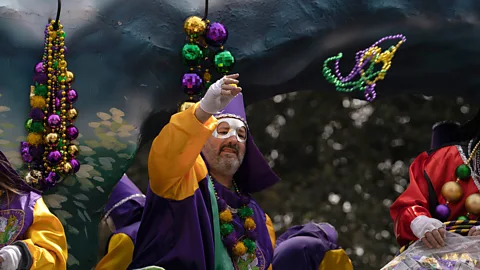Rubbish and revelry: Can Mardi Gras go 'green'?
 Abdul Aziz
Abdul AzizA successful Mardi Gras used to be measured by how much waste it produced. Now, the world's largest free festival is trying to clean up.
The mood is festive as I board the pink and purple Mardi Gras float. Beautiful glass beads hang from hooks lined up above my head while burlap bags full of sustainable "throws" – the local moniker for items thrown to parade viewers, including biodegradable glitter and colourful but sustainably packaged beignet mix – sit at my feet. A jaunty brass rendition of the song "Do whatcha wanna", a Mardi Gras classic, fills the air as marching bands do quick practice runs of their sets. The Krewe of Freret, the first Mardi Gras parade to completely outlaw plastic throws, is ready to roll, kicking off a party that is both one of the most beloved and one of the most environmentally damaging festivals in New Orleans.
The Mardi Gras revelry in this city is known the world over. New Orleans welcomes millions of visitors during carnival season and more than 50 parades roll down the main streets of St Charles and Canal. Local bars and music venues are packed to the walls with tourists while elaborate Mardi Gras balls and other events meant mostly for locals happen behind closed doors. All in all, nearly $900m in income comes from the festivities, according to a recent Economic Impact study – almost 4% of the city's annual revenue.
The celebration lasts for more than a month, with "local" parades like the dog-themed Barkus, where people dress their furry friends in Mardi Gras costumes and parade them through the French Quarter, rolling as early as three weeks before the final – and most famous – parades on "Fat Tuesday". These often include celebrity guests, massive floats and the iconic and ubiquitous plastic beads thrown by the handful into the crowds.
Unfortunately, all this fun also leads to an equal amount of rubbish. It's estimated that Mardi Gras creates around 1,000 tons of waste every year. In 2018, 93,000lb of plastic beads were found clogging up the city's sewer system, a dire situation in a city that lies partially below sea level and whose sewer systems are needed to keep the city dry. After the parades, rubbish can be knee-deep in the streets, and beads and streamers hang from trees like the Spanish moss native to the area. Though the city's Department of Sanitation does an almost miraculous job of cleaning the streets between parades, refuse still makes its way into the waterways in and around the city, posing a threat to both wildlife and people.
This year, however, a coalition of grassroots organisations, and individual "krewes", the local groups responsible for putting on the Mardi Gras parades, are attempting a transformation with the help of the city and some ive sponsors. From massive recycling projects to biodegradable throws, New Orleans is doing its best to clean up its act.
 Abdul Aziz
Abdul AzizA party with a toxic problem
According to a 2020 report by the Ecology Center, the plastic used to make Mardi Gras beads is toxic, containing high concentrations of arsenic, chlorine and lead. Further, the report found strong evidence that these beads are made from recycled e-waste, plastic from electronics treated with flame retardants. The sheer volume of beads that end up in the streets and sewers raises fears that these toxins will leach into their surroundings. Indeed, the areas around parade routes have already been found to have elevated lead levels and some of the chemicals found in the beads have been linked to increased cancer risk.
For a city that's both at major risk of flooding and located in what's known as Cancer Alley – an 85-mile stretch along the banks of the Mississippi River between New Orleans and Baton Rouge where residents have higher rates of cancer due to pollution from nearby petrochemical and manufacturing plants – continuing to throw a massive party that stands to increase the risk of both may seem ill advised. However, the tradition of cheap plastic throws in some ways fuels the entire event.
"It is the largest celebration in the world, but who pays for it">window._taboola = window._taboola || []; _taboola.push({ mode: 'alternating-thumbnails-a', container: 'taboola-below-article', placement: 'Below Article', target_type: 'mix' });
